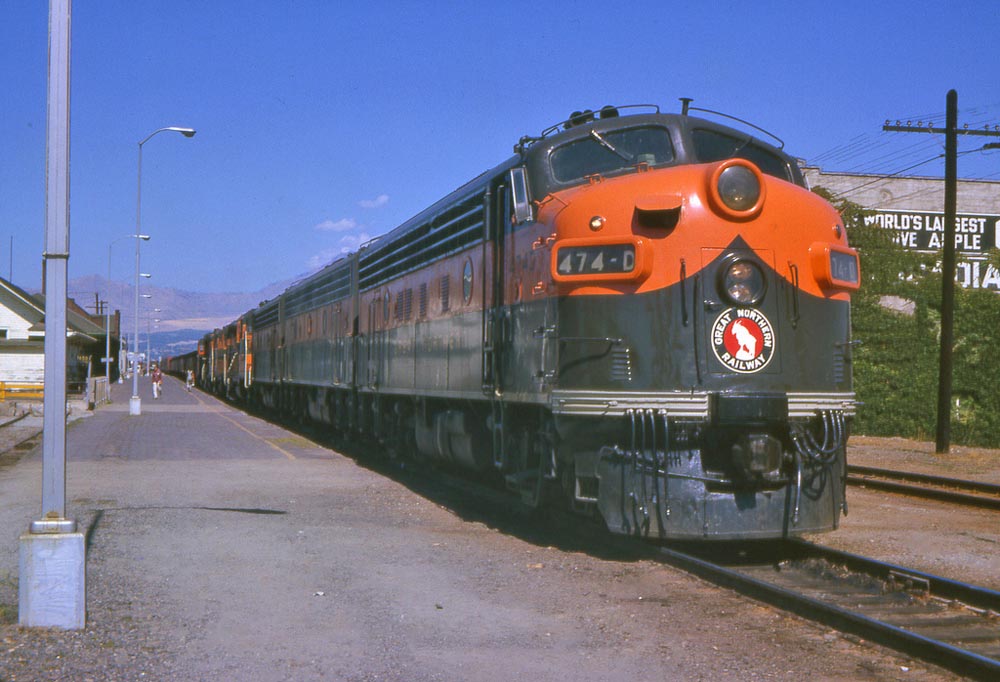My first ride in the cab of a
train in North America was on
Saturday 17th
August 1963. I had just completed my
schooling and spent ten weeks in the USA before returning to
take up a
position with British Railways. I was in Wenatchee, Washington, in the Pacific North
West. Wenatchee lies to the east of the
Cascade mountains in very dry
country which suffers from summer drought.
The town is served by the single track main line of the Great Northern
Railway,
now part of the Burlington Northern Santa Fe. Wenatchee has a fruit growing
industry and in
the picking season the large refrigerator cars are very much in
evidence.
Engineer Williams was in charge
of train 88. He had seven units, a total of 13,500 horse power,
weighing 871
tons. The locomotives for this train
comprised three F9s, three GP20s and one of the then new GP30s and had
a total
length of 350 feet. Climbing into the cab of the leading F9, which was
painted
a pleasing livery of green and orange, the first thing that caught my
eye was
the water cooler. In contrast to the British steam locomotives I had
worked on,
the engineer had a comfortable seat, so comfortable, that there
was a painted
sign:
"Do not place feet on
windshield”
Although he had a padded seat,
the engineer had to exhibit a great deal of skill in the handling of
his 5,300
ton train of 118 cars which, together with the locomotive was one and a
quarter
miles long. The radio crackled into life:
"Highball eastbound train
eighty-eight"
The message was repeated and
with a hiss the independent brake was released, the bell started to
ring and
the throttle was advanced into the first notch. No attempt was made to
exceed
three miles per hour until all of the coupler slack had been taken out
of the
train. After what seemed an age, the conductor in the caboose radioed
that the
end was at last moving and we speeded up, winding our way along the Columbia River valley past the Fruit Growers
Express depot
with its many rows of orange cars. With the controller opened full, we
rapidly
accelerated to 46 mph across the river and past the Rock Island Dam
with its
distinctive fish ladders by which the fish ascend the dam. Riding in
the cab
was very comfortable at this speed, but there was some harder work
ahead. The
sides of the valley began to close in around us and we could see the
beginning
of a formidable one per cent grade. A yellow signal for permanent way
work
spoilt any chances of a run at the climb of almost 700 feet in 15 miles
and,
although the throttle was opened full, speed fell steadily to 25 mph.
We held
this speed all the way around Horseshoe Curve, where the train reversed
direction and we could see the back of the train going the opposite
way.
Outside the temperature was in the upper nineties in this dry, arid
land where
very little will grow except with the aid of irrigation.
ll too soon we heard the air brake being
applied to slow the train to a walking pace so that I could drop off
with Joe
Gaynor, the Assistant Master Mechanic, whose wife was waiting to take
us back
to Wenatchee. I stood on the platform at Quincy
and
watched the cars roll by. The land was
perfectly flat and at one time the train seemed to stretch from horizon
to
horizon. So this was North American
railroading.
No loose coupled trains here relying upon the locomotive and van brakes
(and a
good deal of luck). Everything was bigger - locomotives, freight
cars and
train lengths. This one short trip was to whet my appetite for North
American
railroading. I suppose that after this it was inevitable that I should
one day
come back
On the way back to Wenatchee,
I learned that
railroad life does have its lighter side. One day an engineer was
taking a drag
freight through the Cascade Tunnel which, at that time, was
electrified. After some
time, he realized that the end of the tunnel was not getting any closer
and he realized
that he had stalled. However, the throttle
was still full open, and when assistance arrived it was found that the
wheels
had ground themselves into the rails so that the locomotive was
stuck fast. From that day on, the engineer
carried a broom
with him which he would periodically stick out of the cab against
the tunnel
wall to assure himself that he was in fact still moving
Ottawa Valley
Associated Railroaders, The Interchange May 2009.
